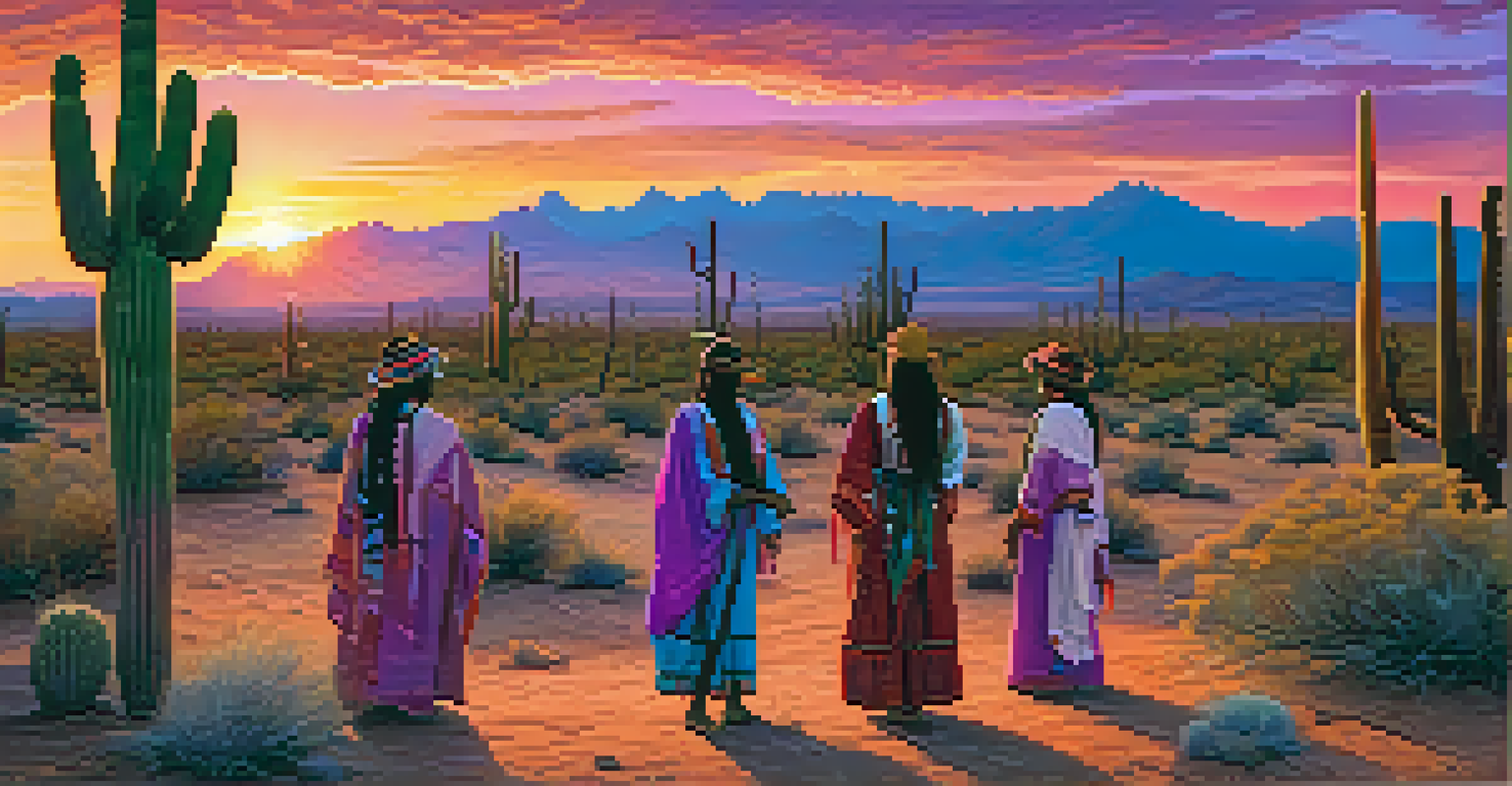The Importance of Indigenous Languages in Arizona's Culture

Indigenous Languages: A Window into Arizona's History
Indigenous languages serve as crucial links to the past, revealing the rich history of Arizona's Native tribes. Each language carries stories, traditions, and values that have been passed down through generations, providing insights into how these communities have interacted with the land. For instance, the Navajo language, with its unique syntax and vocabulary, reflects the tribe's deep connection to the natural world and their cultural practices. By preserving these languages, we not only honor the past but also keep alive the wisdom embedded in them.
Language is the road map of a culture. It tells you where its people come from and where they are going.
Language is more than just communication; it is a vessel for cultural identity. In Arizona, Indigenous languages help maintain a sense of belonging and unity within tribes. When community members speak their native tongue, they reinforce their shared heritage and cultural pride. This connection fosters a stronger bond among individuals and encourages younger generations to learn their ancestral languages, ensuring that these identities flourish.
Moreover, Indigenous languages contribute to the diversity of Arizona’s cultural tapestry. As tourists and locals alike engage with these languages, they gain a broader understanding of the state’s multifaceted identity. This not only enhances cultural appreciation but also promotes respectful interactions between different communities, bridging gaps and fostering harmony.
Language Revitalization Efforts in Arizona
Revitalizing Indigenous languages has become a priority in Arizona, with various initiatives aimed at teaching and promoting these languages. Programs in schools and community centers focus on language immersion, encouraging children to speak their native tongue from an early age. These programs not only improve language skills but also instill a sense of pride in cultural heritage, helping to combat the effects of historical language loss.

Community workshops and cultural events also play a significant role in language revitalization. Events such as storytelling nights and traditional ceremonies often incorporate Indigenous languages, allowing community members to practice and celebrate their linguistic heritage. These gatherings create a safe space for learning and sharing, reinforcing the importance of language in cultural identity.
Indigenous Languages Connect History
Indigenous languages in Arizona reveal the rich history and cultural practices of Native tribes, serving as vital links to their past.
Moreover, the use of technology, including mobile apps and online courses, has made it easier for individuals to learn Indigenous languages. These resources provide accessible platforms for people of all ages to engage with their language, promoting continuous learning and interest. As more individuals embrace these tools, the hope is to create a sustainable cycle of language use and preservation.
The Role of Indigenous Languages in Cultural Identity
Indigenous languages are fundamental to the cultural identity of tribes in Arizona. They encapsulate unique worldviews, philosophies, and customs that are distinct to each community. For example, the Hopi language includes specific terms that describe their agricultural practices, which are deeply intertwined with their cultural rituals and celebrations. This connection between language and identity underscores the importance of preserving these languages for future generations.
A language is something infinitely greater than grammar and philology. It is the poetic testament of the genius of a race and the culture which has created it.
Cultural identity can be seen as a tapestry woven from various threads, and language is one of the most vibrant. When individuals speak their Indigenous language, they express their heritage and connect with their ancestors. This sense of belonging encourages pride and resilience, especially in the face of challenges that Indigenous communities have historically faced.
Furthermore, the revitalization of Indigenous languages often leads to a renaissance of cultural practices. As people reconnect with their languages, they also revive traditional songs, dances, and storytelling methods that might have been lost over time. This cultural resurgence not only strengthens community ties but also enriches Arizona's cultural landscape as a whole.
Challenges Facing Indigenous Language Preservation
Despite the positive strides in language revitalization, Indigenous languages in Arizona face numerous challenges. One of the most significant hurdles is the limited number of fluent speakers, many of whom are elderly. As these speakers age, there is an urgent need to pass on their knowledge to younger generations, who may not have the same opportunities to learn. This generational gap poses a risk of language extinction if not addressed promptly.
Additionally, the influence of dominant languages, like English and Spanish, can overshadow Indigenous languages. In many cases, children may prioritize learning these more widely spoken languages for practical reasons, leading to a decline in Indigenous language use at home and in daily life. This shift emphasizes the need for targeted efforts to make Indigenous languages relevant and appealing to younger audiences.
Revitalization Efforts Gain Momentum
Community initiatives and educational programs are essential for revitalizing Indigenous languages and instilling cultural pride in younger generations.
Moreover, funding and resources for language programs can be limited, which hinders comprehensive revitalization efforts. Many communities rely on grants and donations to support their initiatives, making it challenging to sustain long-term language education. Addressing these challenges requires collaboration between tribes, educational institutions, and government agencies to create a robust framework for language preservation.
The Impact of Indigenous Languages on Education
Integrating Indigenous languages into educational curricula can significantly enhance cultural awareness among students. Schools in Arizona that offer Indigenous language courses provide students with the opportunity to learn about the history and traditions of local tribes. This education not only enriches the students’ academic experience but also fosters respect for the diverse cultures that shape Arizona's identity.
Moreover, bilingual education models that include Indigenous languages have shown promising outcomes in student engagement and achievement. Research indicates that students who are taught in their native language perform better academically, as they can relate the material to their cultural context. This approach empowers students to embrace their heritage while gaining essential skills for the future.
As Indigenous languages gain recognition in educational settings, they also promote inclusivity and diversity. By valuing these languages, schools send a message that all cultures are important and worthy of respect. This inclusivity helps cultivate a sense of community among students, fostering understanding and appreciation for the rich cultural mosaic that exists in Arizona.
Indigenous Languages and Economic Opportunities
The promotion of Indigenous languages can also lead to economic opportunities within Arizona's Native communities. As more people learn these languages, there is a growing demand for language interpreters and educators. This demand not only provides job opportunities but also reinforces the value of Indigenous languages in various sectors, including tourism, education, and healthcare.
Cultural tourism is one area where Indigenous languages can play a vital role. Tourists often seek authentic experiences, and learning about Indigenous languages can deepen their understanding of the culture. This interest can lead to increased tourism revenues, benefitting local communities and supporting language preservation initiatives at the same time.
Languages Foster Economic Growth
Promoting Indigenous languages can lead to economic opportunities through cultural tourism and the demand for language expertise in various sectors.
Additionally, businesses that emphasize Indigenous language and culture can attract a broader audience. Companies that incorporate local languages into their branding or marketing often resonate better with Indigenous customers, fostering loyalty and community support. This intersection of language and economic development highlights the multifaceted benefits of preserving and promoting Indigenous languages.
The Future of Indigenous Languages in Arizona
Looking ahead, the future of Indigenous languages in Arizona holds both challenges and opportunities. With increasing awareness of the importance of these languages, there is hope that communities will continue to prioritize language preservation. Initiatives that involve collaboration between tribes, educational institutions, and local governments can create sustainable frameworks for language revitalization efforts.
Community engagement is essential for the future of Indigenous languages. As younger generations take an active role in advocating for their languages, their passion can catalyze transformation. Programs that empower youth to become language advocates can inspire a new wave of interest and participation in cultural practices that utilize Indigenous languages.

Ultimately, the resilience of Indigenous languages in Arizona will depend on collective efforts to honor and celebrate these linguistic treasures. By recognizing the vital role they play in shaping cultural identity and community cohesion, we can work towards a future where Indigenous languages not only survive but thrive, enriching the cultural landscape of Arizona for generations to come.